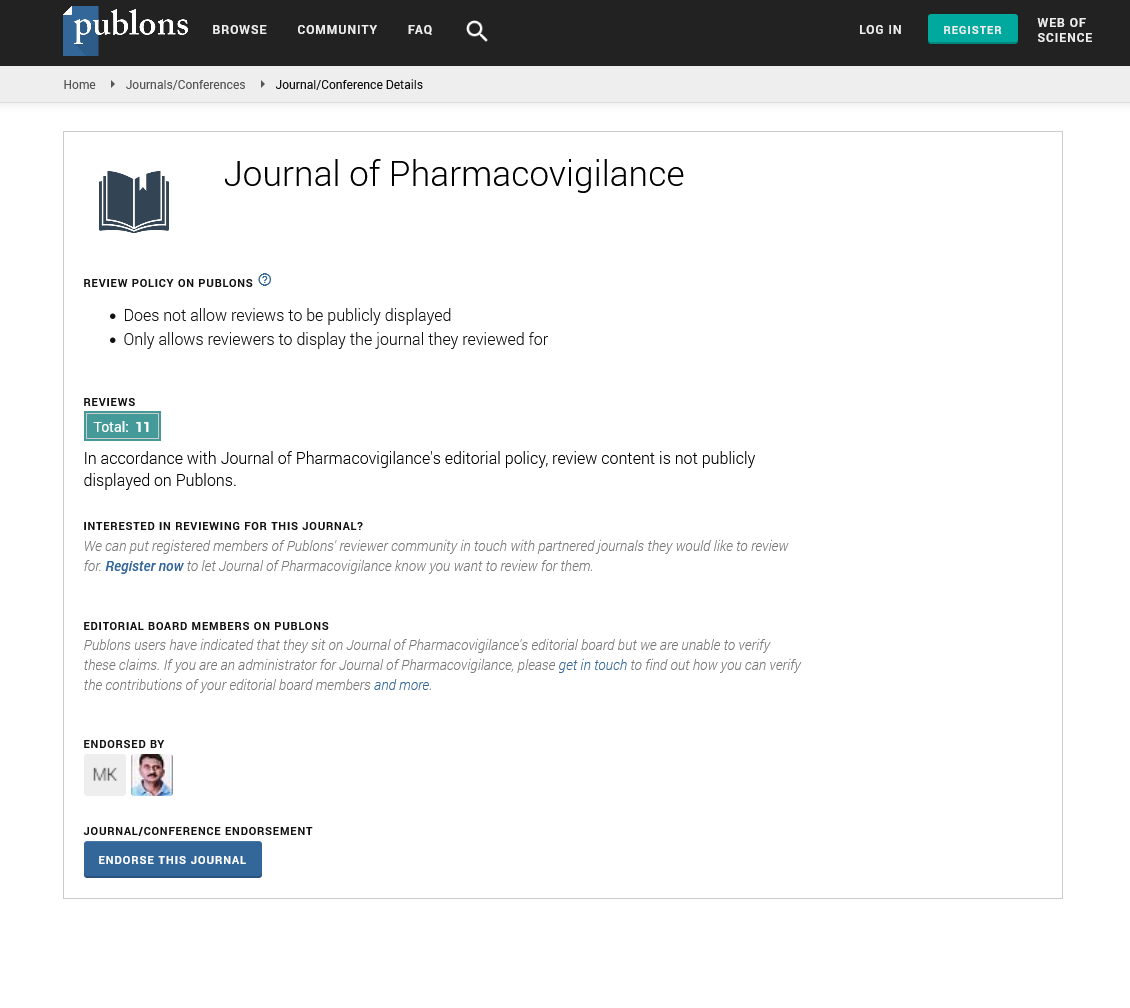Indexed In
- Open J Gate
- JournalTOCs
- The Global Impact Factor (GIF)
- RefSeek
- Hamdard University
- EBSCO A-Z
- OCLC- WorldCat
- Publons
- Euro Pub
- Google Scholar
Useful Links
Share This Page
Journal Flyer

Open Access Journals
- Agri and Aquaculture
- Biochemistry
- Bioinformatics & Systems Biology
- Business & Management
- Chemistry
- Clinical Sciences
- Engineering
- Food & Nutrition
- General Science
- Genetics & Molecular Biology
- Immunology & Microbiology
- Medical Sciences
- Neuroscience & Psychology
- Nursing & Health Care
- Pharmaceutical Sciences
Opinion - (2024) Volume 12, Issue 3
Pharmacovigilance Challenges for Over-the-Counter Drug Safety Monitoring
Maeve Ellis*Received: 28-Aug-2024, Manuscript No. JP-24-27175; Editor assigned: 30-Aug-2024, Pre QC No. JP-24-27175(PQ); Reviewed: 13-Sep-2024, QC No. JP-24-27175; Revised: 20-Sep-2024, Manuscript No. JP-24-27175(R); Published: 27-Sep-2024, DOI: 10.35248/2329-6887.24.12.488
Description
The global market for Over-the-Counter Drugs (OTC Drugs) has expanded significantly in recent years, driven by factors such as increased healthcare costs, greater consumer health awareness and the desire for convenient access to treatment. OTC drugs encompass a wide range of products, including pain relievers, cold and flu medications, antacids and dietary supplements. While these medications offer numerous benefits, including ease of access and reduced burden on healthcare systems, they also pose risks that must be carefully managed. However, in the contemporary healthcare landscape, the rise of OTC drugs presents new challenges and opportunities for pharmacovigilance. OTC drugs, while generally considered safe for self-medication, are not devoid of risks. Ensuring their safety requires a nuanced approach to pharmacovigilance that addresses the unique characteristics and usage patterns of these widely accessible medications. Consumers often use OTC drugs without professional guidance, increasing the risk of misuse and overuse. This can lead to Adverse Drug Reactions (ADRs), drug interactions and potential dependency. ADRs associated with OTC drugs are frequently underreported, as consumers may not recognize them as adverse effects or may not know how to report them. This underreporting complicates the detection of safety signals and risk assessment. Without regular clinical oversight, the detection and management of ADRs become more challenging. Healthcare professionals may not be aware of all the OTC medications their patients are using, leading to gaps in patient safety monitoring. The widespread availability and extensive use of OTC drugs mean that pharmacovigilance systems must handle vast amounts of data from diverse sources, making data collection and analysis more complex. To address these challenges and enhance the safety of OTC drugs, several proactive pharmacovigilance strategies can be implemented.
Public awareness campaigns can inform people about potential ADRs, the importance of reading labels and the need to adhere to recommended dosages. Encouraging consumers to report any adverse effects they experience can improve ADR reporting rates. Developing user-friendly ADR reporting systems can facilitate the reporting process for consumers. Mobile applications, online portals and toll-free helplines can make it easier for individuals to report ADRs and seek guidance. Simplifying the reporting process can help capture more data on OTC drug safety. Integrating OTC drug data into EHRs can provide healthcare professionals with a comprehensive view of their patients' medication usage. Active surveillance systems that continuously monitor data from various sources, including social media, online forums and consumer reviews, can identify emerging safety signals. Advanced data analytics and Artificial Intelligence (AI) can help analyze large datasets, detect patterns and predict potential risks associated with OTC drugs. Retailers and pharmacies play a critical role in OTC drug distribution and can contribute to pharmacovigilance efforts. Collaborating with these stakeholders to provide educational materials, conduct surveys and collect Adverse Drug Reaction (ADR) reports can enhance the safety monitoring of OTC drugs. Developing and implementing Registered Medical Practitioner (RMPs) for OTC drugs can help identify, assess and mitigate risks associated with their use. RMPs can include specific safety studies, risk communication activities and post-marketing surveillance requirements customized to OTC medications.
Conclusion
A notable example of enhancing OTC pharmacovigilance is the U.S. Food and Drug Administration's (FDA) nonprescription drug safe use regulatory framework. The FDA has implemented stringent labeling requirements for OTC drugs to ensure that consumers have clear and accurate information about their use, potential ADRs and safety precautions. The FDA has established public reporting systems, such as the MedWatch program, to encourage consumers and healthcare professionals to report ADRs associated with OTC drugs. The data collected through these systems is used to identify safety signals and take regulatory actions as needed. The FDA actively monitors data from various sources, including social media, online reviews and Electronic Health Record (EHR) to detect emerging safety issues with OTC drugs. This proactive approach allows for timely identification and management of risks. The FDA collaborates with academic institutions, industry stakeholders and international regulatory agencies to conduct research on the safety and efficacy of OTC drugs.
Citation: Ellis M (2024). Pharmacovigilance Challenges for Over-the-Counter Drug Safety Monitoring. J Pharmacovigil. 12:488.
Copyright: © 2024 Ellis M. This is an open-access article distributed under the terms of the Creative Commons Attribution License, which permits unrestricted use, distribution, and reproduction in any medium, provided the original author and source are credited.

